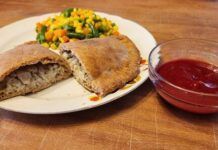
Click here to subscribe today or Login.
Tuesday, June 30, 1998 Page: 1B
Great way to enjoy it is to brisket
That special outdoor party is Sunday and the weatherman is calling for a
rainy weekend. What do you serve if we have to be indoors?
Don’t panic. I have the answerThe last couple of weeks we have been
covering the basic principals of different cooking methods. This week we will
be talking about braising. You can serve braised brisket of beef for your
indoor party.
Braising is referred to as a combination cooking method because both dry
heat and moist heat cooking methods are used to achieve the desired results.
Braised meats are first browned on the top of the stove (that’s the dry heat)
and then finished covered in a liquid in the oven (the moist heat).
A well-prepared braised dish has the rich flavor of the meat in the sauce
and the moisture and flavor of the sauce in the meat. Braising is most often
done with tougher more developed muscle cuts of meat. Those cuts also happen
to contain a large amount of collagen tissue which adds to the rich flavor of
the sauce.
As a general rule, smaller cuts of meat are first floured before browning;
larger cuts such as the brisket are not.
Braised brisket
Serves 8 to 10 people
Vegetable oil- 3 ounces
Beef Brisket- 6 pounds
Two medium onions, sliced thin
Garlic, minced- 2 tablespoons
Dry red wine- 3 ounces
Beef stock- 1 quart
Tomato sauce- 1 pint
Brown sugar- 4 ounces
Paprika- 1 teaspoon
Dry mustard- 2 teaspoons
Lemon juice- 8 ounces
Tomato ketchup- 8 ounces
Red wine vinegar- 8 ounces
Worcestershire sauce- 2 ounces
Salt and pepper to taste
Ask your butcher for a 6-pound beef brisket with the fat cap removed.
Brisket has a natural fatty cap which sits on top of the piece. (Corned beef
hash is sometimes made from this.) This is of no value for this recipe.
The brisket is the chest plate of the animal. Good corned beef is made from
the brisket. Beware of cheaper corned beef that uses the bottom round.
Corned beef goes through a pickling process called corning which gives it a
reddish color. The brisket in this recipe has not gone through this process.
Ideally, the big pan you brown your meat in should have a lid that fits on
the pan and is able to go into the oven. Thus, you will be able to do all the
steps in one pan.
If you don’t have such a pan and lid, brown the meat in a large saute pan
and then transfer it to a large casserole type dish with a lid. All braised
items are simmered covered.
Heat oil in the pan on the stove top till it reaches the smoke point. Brown
the meat well on both sides. Browning adds color to the meat and flavor to the
finished sauce. Remove the brisket and set aside.
In the same pan, brown the onions to a golden brown. Add garlic and stir.
Add wine to de glaze the fond (caramelized juices on the bottom of the pan).
If you are transferring to a casserole dish, do it now making sure to remove
all particles from the saute pan. Add stock and tomato sauce. Add rest of
ingredients.
Return the brisket to the liquid and cover with the lid. First, bring to a
boil on top of the stove. All braising liquids should be brought to the boil
before entering the oven since it will take too long for a cold liquid to come
to a simmer in the oven.
Braise at a simmer in a 325 degree oven for approximately two and a half to
three hours, or until tender. Turn the brisket over and baste every 30
minutes.
To tell if the meat is done, insert a paring knife straight down into the
center of the meat and try to lift it. If the meat can be lifted with the
knife it is not done. If the knife slips out of the meat when trying to lift
it is done. Remove the brisket and set on the carving board to rest.
To finish the sauce, remove any grease from the top of the braising liquids
and discard. Check the consistency of the sauce. Because we did not flour our
large cut of meat before browning our sauce might be a little thin. If you
think it needs a little thickening add some cornstarch dissolved in water
(called a slurry) to the boiling sauce. Add slowly; thickening will occur
immediately if your liquid is boiling. (Cornstarch thickens at 176 degrees.)
Taste for seasoning. Pour the sauce into a serving dish, but do not strain.
Slice the beef against the grain and serve with the sauce. This dish can be
done ahead of time sliced and put back in the sauce. Reheat covered in a 325
degree oven.
Now aren’t you glad your party was rained out this weekend?
Members of the Professional Chefs of Nort







